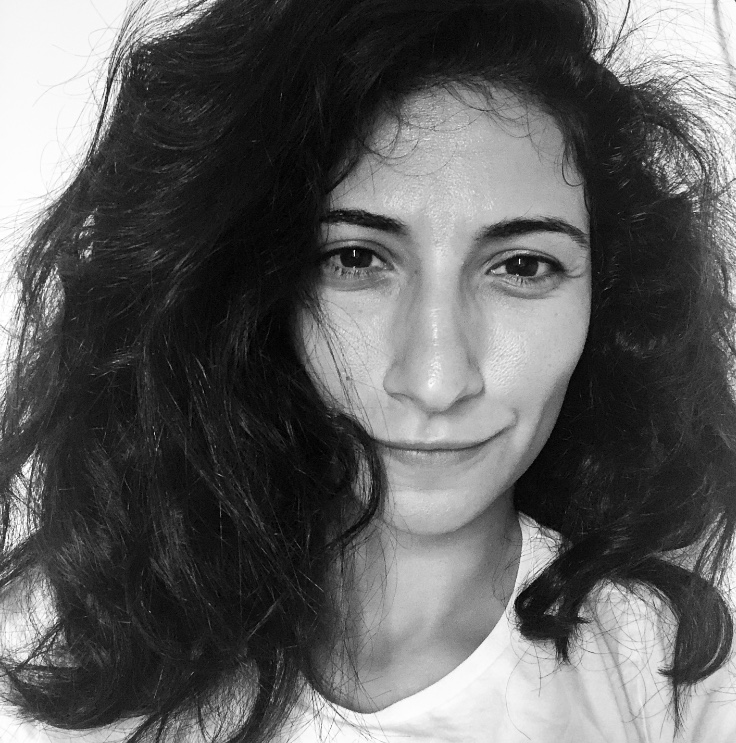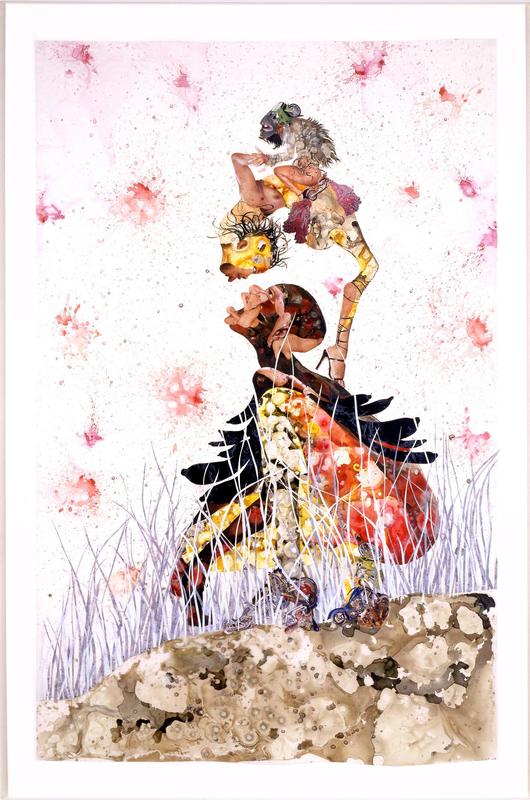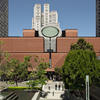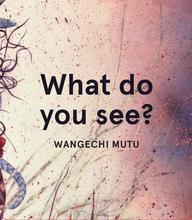More about Misguided Little Unforgivable Hierarchies
- All
- Info
- Shop

Contributor
Wangechi Mutu’s Misguided Little Unforgivable Hierarchies looks like a scene out of Cirque du Soleil thanks to the contortions of the figures stacked atop each other.
This is a far cry from Georges Seurat's Circus Sideshow, though like his Pointillist canvases, Mutu's paintings are, too, a sum of their parts. At first, one doesn’t realize the figures are made up of a collage of body parts. Zoom in and you'll see they are composed of a jumble of smaller disembodied limbs and torsos, many of which seem to be sexualized images of naked light-skinned women, like the kind you'd see in Maxim or Playboy. As one author puts it, the way Mutu chops up the bodies from pornographic magazines and uses them at different scales makes her figures "simultaneously alluring and strange," mingling "haunting violence" with "glamorous sensuality."
Misguided Little Unforgiven Hierarchies, which is a mix of acrylic, collage, and ink, also uses cutouts from motorcycle magazines. If you zoom in a bit more, you can see at the very top a figure sitting on a miniature motorcycle, with another motorcycle on its head. The motorcycle parts are something Mutu also used in the painting One Hundred Lavish Months of Bushwhack, and which recur in much of her work. By juxtaposing the soft supple flesh with the sleek and hard metal of the motorcycle, her figures appear like cyborgs, the contemporary machinery merged incongruously with the soft watercolor stains that make up the rest of their bodies.
The back-bender's high heel, pressed down into the back of the bottom figure, could be understood as a reference to the oppression of women, and Black women more specifically. The amalgamation of the specific imagery in this work, coupled with the title, suggests the complex "unforgivable hierarchies" that exist within the intersections of gender and race. Mutu's work is also interested in exploring the treatment of Black women's bodies in Western Art, and the idea of traditional beauty. Perhaps this is down to her own experience traveling from her home in Nairobi, Kenya to study art in the United States.
For the background, which at first appears like wallpaper, Mutu uses red splatters that both resemble blood and blossoms. The blood splatters are evocative of the bloody history of colonialism, another result of "misguided" and "unforgivable hierarchies." Much of the African continent has come under attack, siege, and thievery by white European countries, North America, and Australia. The consequence of this grab for natural resources, and an expansion of whatever empire was running the show at the time, is often violence and suffering.
Sources
- Brooklyn Museum, “Wangechi Mutu: a fantastic journey.” Accessed June 29, 2021. https://www.brooklynmuseum.org/exhibitions/wangechi_mutu/
- Gordon, Sean, “Wangechi Mutu explores Afrofuturism and the new humanism with Ndoro Na Miti,” Paste Magazine, February 12, 2017. Accessed June 29, 2021. https://www.pastemagazine.com/visual-arts/wangechi-mutu/wangechi-mutu-t…
- Heidi Hirschl Orley, “The feminist challenge of Wangechi Mutu,” MOMA Magazine, February 11, 2021. Accessed June 29, 2021. https://www.moma.org/magazine/articles/506
- MOMA, “Wangechi Mutu: One Hundred Lavish Months of Bushwhack.” Accessed July 18, 2021. https://www.moma.org/collection/works/94766
- San Francisco, “Wangechi Mutu’s alternative mythologies,” The Economist, May 7, 2021. Accessed June 29, 2021. https://www.economist.com/books-and-arts/2021/05/07/wangechi-mutus-alte…
- SFMOMA, “Wangechi Mutu: Misguided Little Unforgivable Hierarchies, 2005.” Accessed June 29, 2021. https://www.sfmoma.org/artwork/2005.184/












